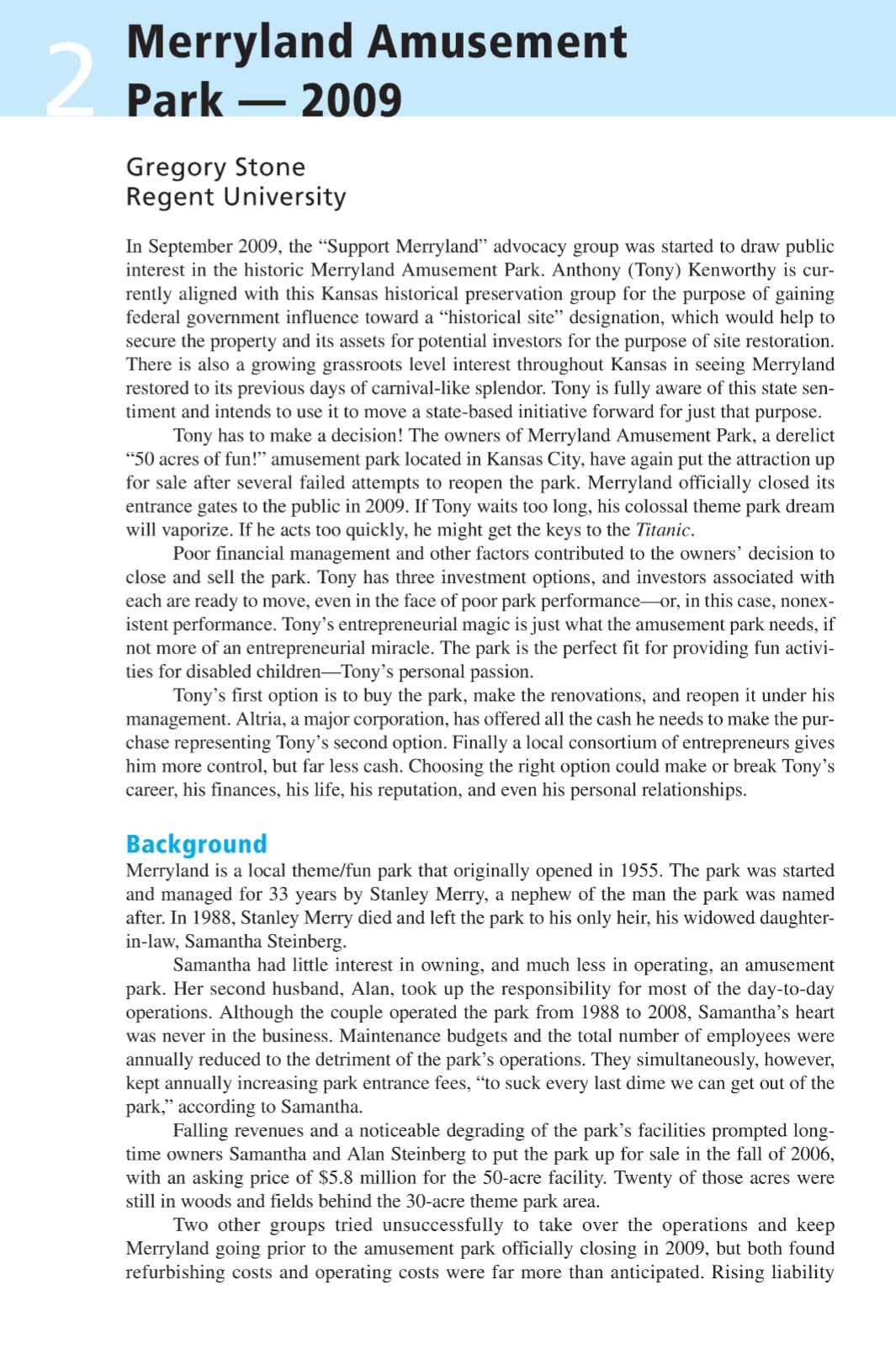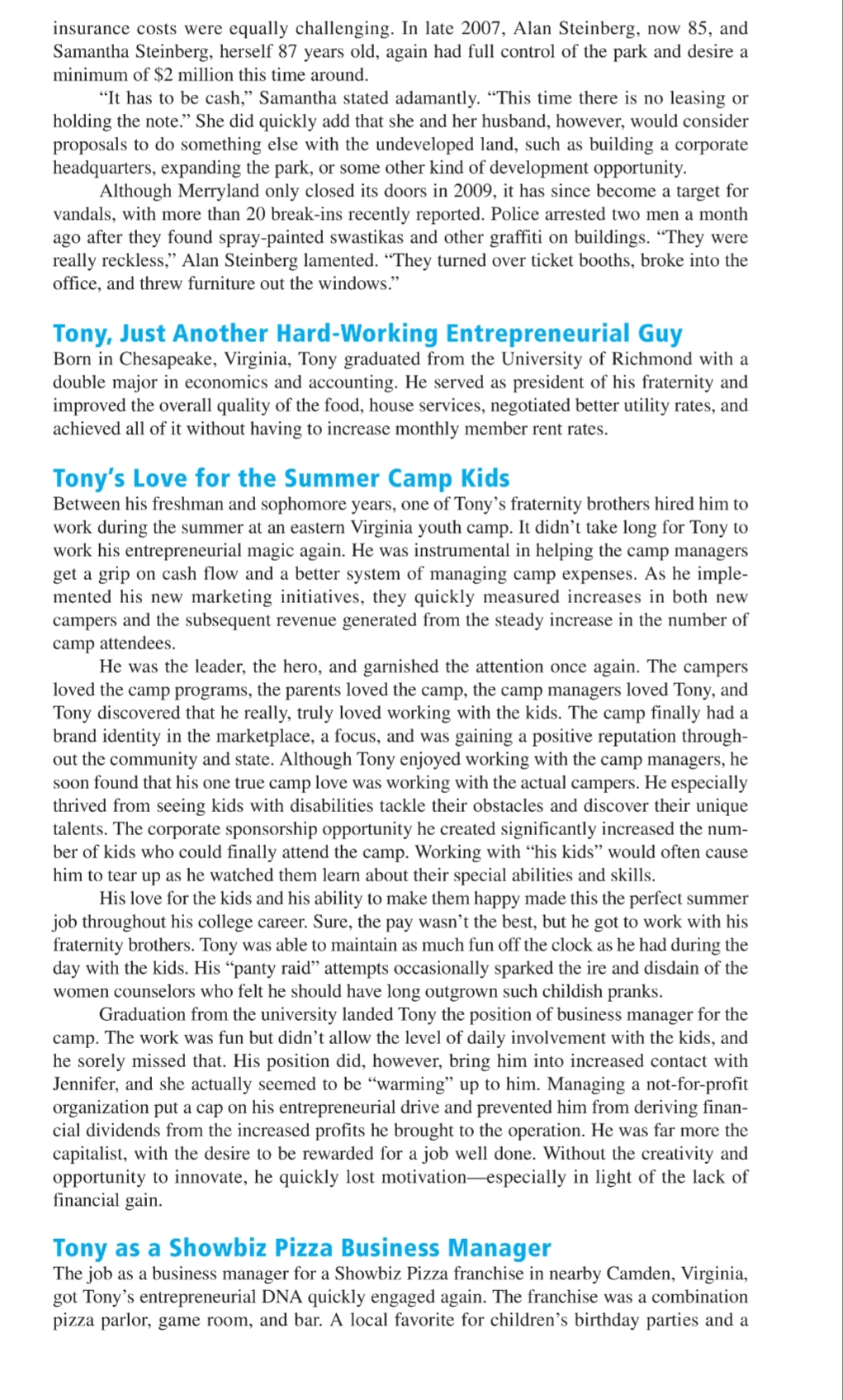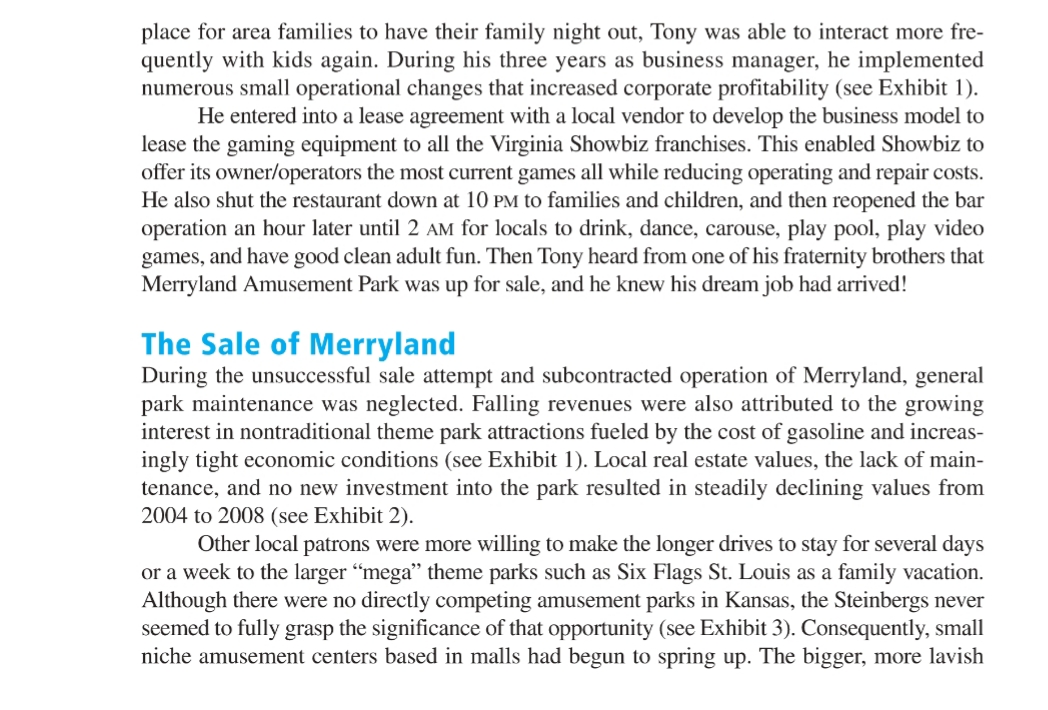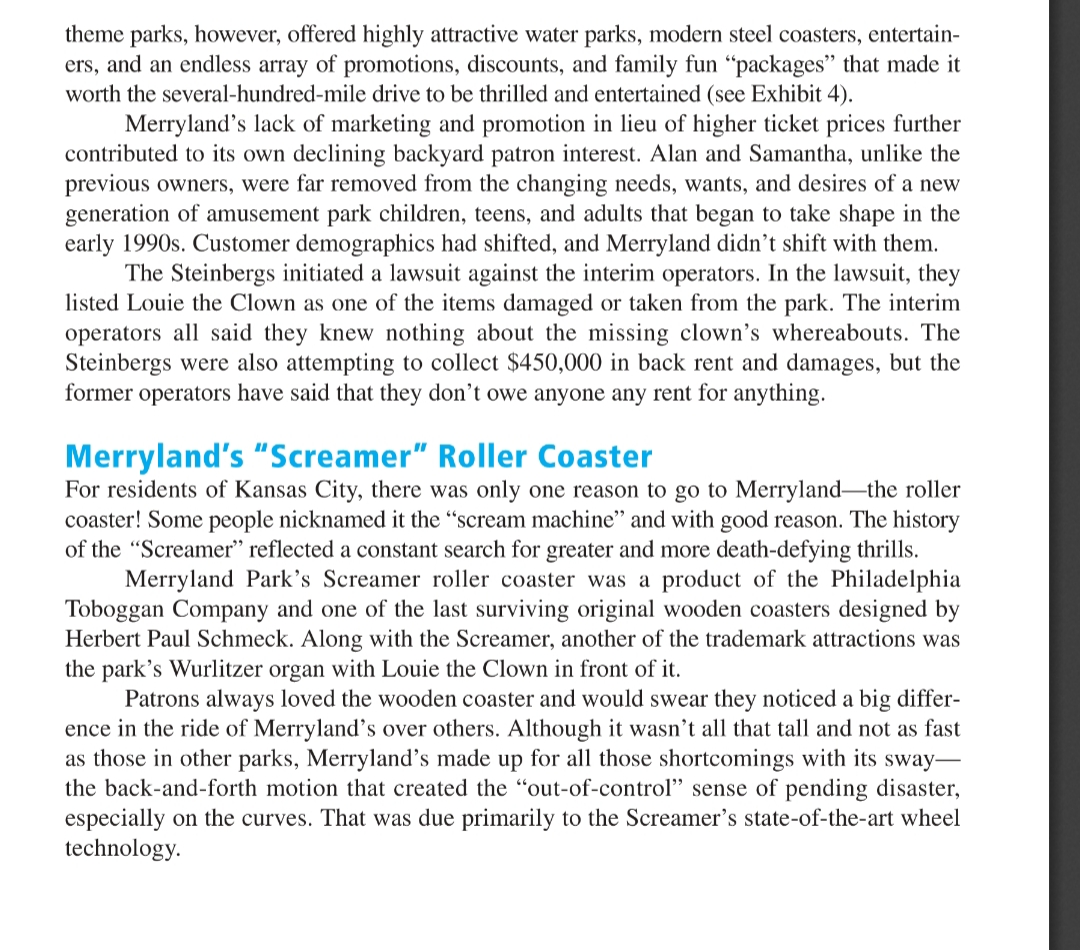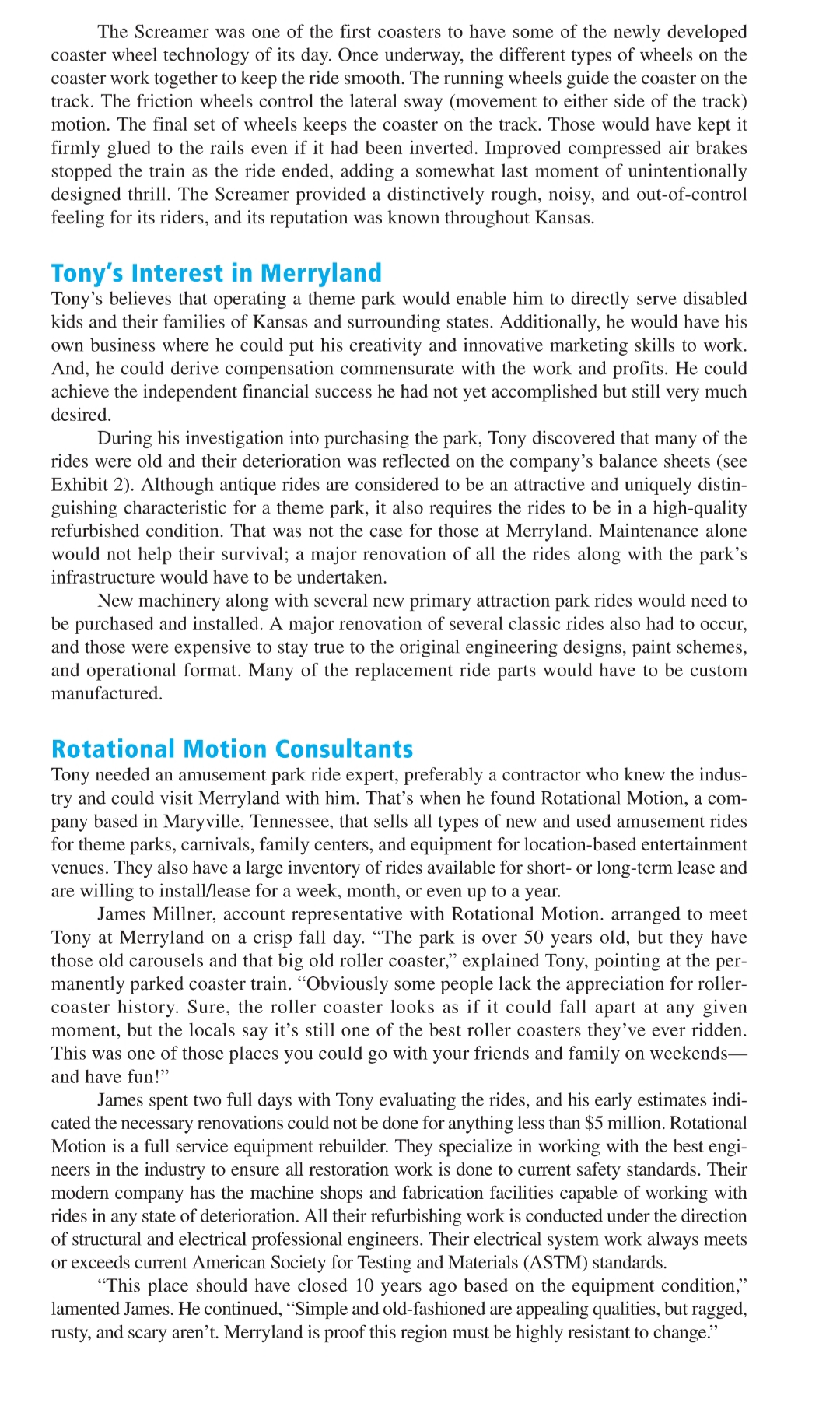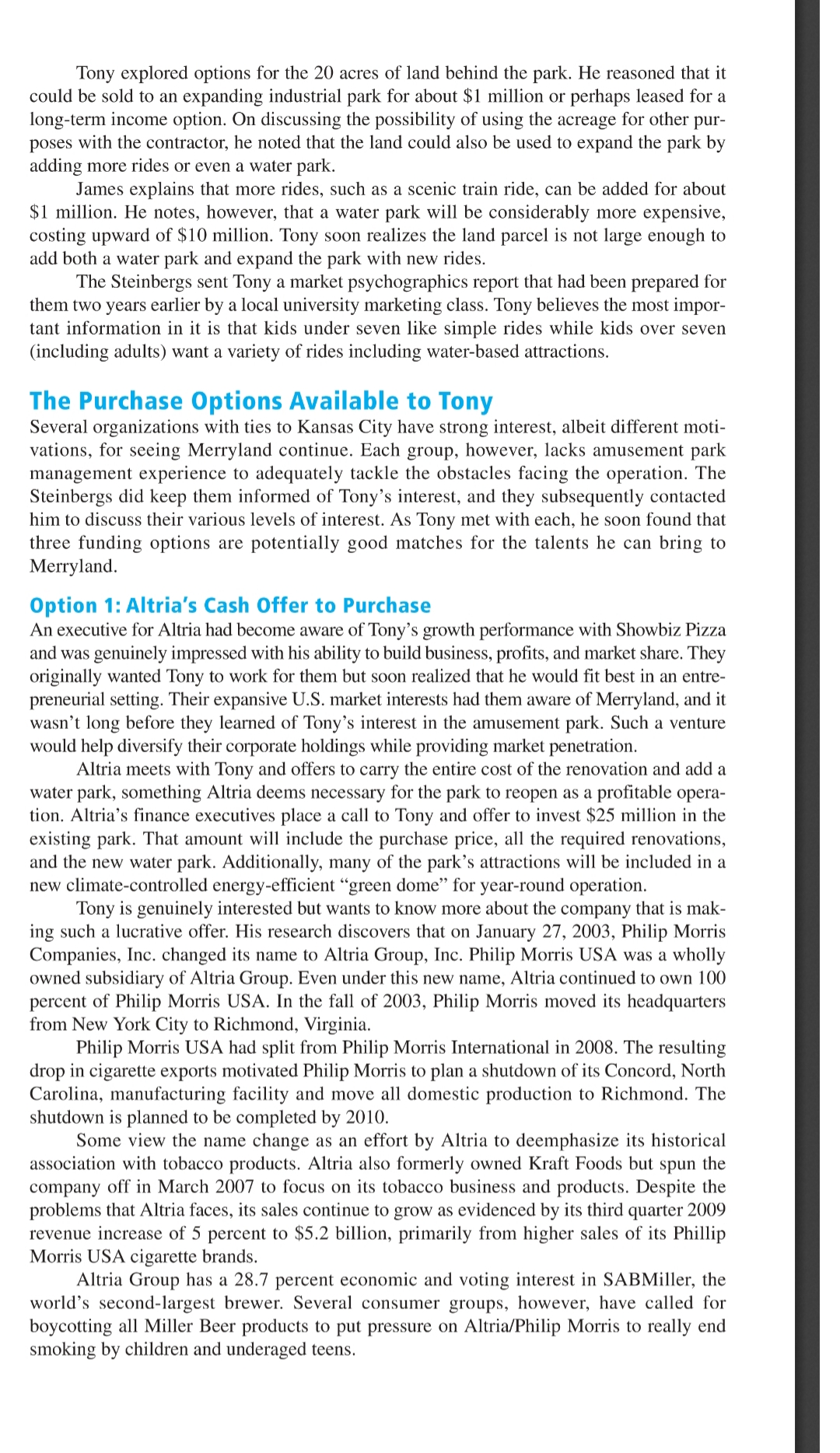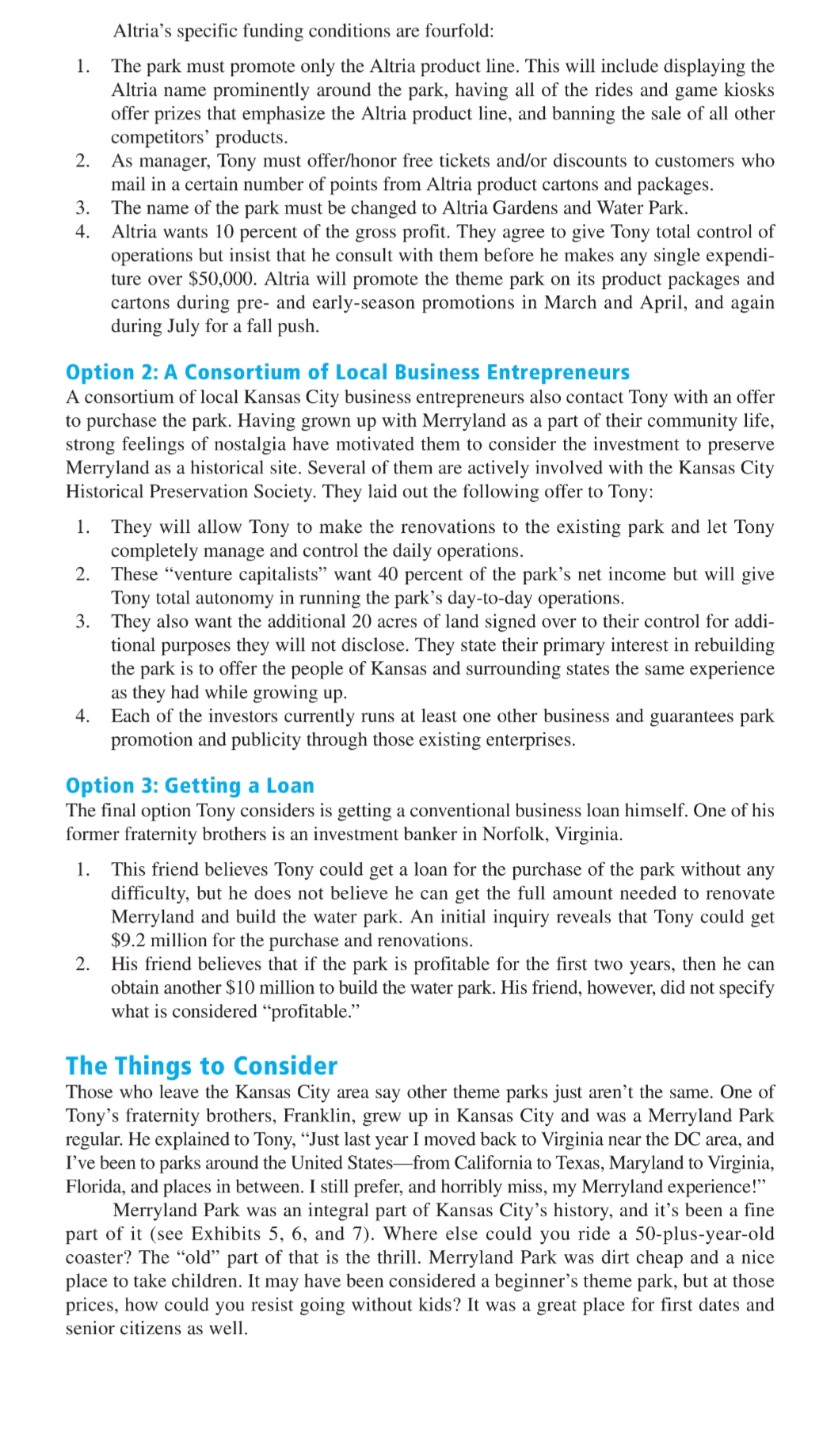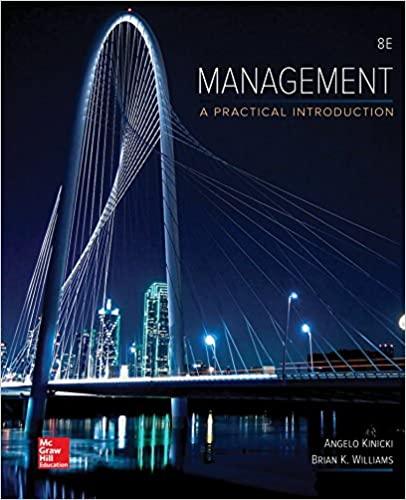What are the Porters five forces in this case? Explain each.
Merryland Amusement Park 2009 Gregory Stone Regentthnverty In September 2009, the \"Support Merryland" advocacy group was started to draw public interest in the historic Merryland Amusement Park. Anthony (Tony) Kenworthy is cur- rently aligned with this Kansas historical preservation group for the purpose of gaining federal government inuence toward a \"historical site\" designation, which would help to secure the property and its assets for potential investors for the purpose of site restoration. There is also a growing grassroots level interest throughout Kansas in seeing Merryland restored to its previous days of camival-like splendor. Tony is fully aware of this state sen- ti ment and intends to use it to move a state-based initiative forward for just that purpose. Tony has to make a decision! The owners of Merryland Amusement Park, a derelict \"50 acres of fun!" amusement park located in Kansas City, have again put the attraction up for sale after several failed attempts to reopen the park. Merryland officially closed its entrance gates to the public in 2009. If Tony waits too long, his colossal theme park dream will vaporize. If he acts too quickly, he might get the keys to the Titanic. Poor nancial management and other factors contributed to the owners' decision to close and sell the park. Tony has three investment options, and investors associated with each are ready to move, even in the face of poor park performanceor, in this case, nonex- istent performance. Tony's entrepreneurial magic is just what the amusement park needs, if not more of an entrepreneurial miracle. The park is the perfect t for providing fun activi- ties for disabled childrenTony's personal passion. Tony's rst option is to buy the park, make the renovations, and reopen it under his management. Altria, a major corporation, has offered all the cash he needs to make the pur- chase representing Tony's second option. Finally a local consortium of entrepreneurs gives him more control, but far less cash. Choosing the right option could make or break Tony's career, his nances, his life, his reputation, and even his personal relationships. Background Merryland is a local themelfun park that originally opened in 1955. The park was started and managed for 33 years by Stanley Merry, a nephew of the man the park was named after. In 1988, Stanley Merry died and left the park to his only heir, his widowed daughter- in-law, Samantha Steinberg. Samantha had little interest in owning, and much less in operating, an amusement park. Her second husband, Alan, took up the responsibility for most of the day-to-day operations- Although the couple operated the park from 1988 to 2008, Samantha's heart was never in the business. Maintenance budgets and the total number of employees were annually reduced to the detriment of the park's operations. They simultaneously, however, kept annually increasing park entrance fees, \"to suck every last dime we can get out of the park,\" according to Samantha. Falling revenues and a noticeable degrading of the park's facilities prompted long- time owners Samantha and Alan Steinberg to put the park up for sale in the fall of 2006, with an asking price of $5.8 million for the 50-acre facility. Twenty of those acres were still in woods and elds behind the 30-acre theme park area. Two other groups tried unsuccessfully to take over the operations and keep Merryland going prior to the amusement park officially closing in 2009, but both found refurbishing costs and operating costs were far more than anticipated. Rising liability insurance costs were equally challenging. In late 2007, Alan Steinberg, now 85, and Samantha Steinberg. herself 8? years old, again had full control of the park and desire a minimum of $2 million this time around. \"It has to be cash," Samantha stated adamantly. \"This time there is no leasing or holding the note.\" She did quickly add that she and her husband, however, would consider proposals to do something else with the undeveloped land, such as building a corporate headquarters. expanding the park, or some other kind of development opportunity. Although Merryland only closed its doors in 2009, it has since become a target for vandals, with more than 20 break-ins recently reported. Police arrested two men a month ago after they found spray-painted swastikas and other grafti on buildings. \"They were really reckless," Alan Steinberg lamented. \"They turned over ticket booths, broke into the ofce, and threw furniture out the windows." Tony, Just Another Hard-Working Entrepreneurial Guy Born in Chesapeake, Virginia, Tony graduated from the University of Richmond with a double major in economics and accounting. He served as president of his fraternity and improved the overall quality of the food, house services, negotiated better utility rates, and achieved all of it without having to increase monthly member rent rates. Tony's Love for the Summer Camp Kids Between his freshman and sophomore years, one of Tony's fraternity brothers hired him to work during the summer at an eastern Virginia youth camp. It didn't take long for Tony to work his entrepreneurial magic again. He was instrumental in helping the camp managers get a grip on cash flow and a better system of managing camp expenses. As he imple- mented his new marketing initiatives, they quickly measured increases in both new campers and the subsequent revenue generated from the steady increase in the number of camp attendees. He was the leader, the hero, and garnished the attention once again. The campers loved the camp programs, the parents loved the camp, the camp managers loved Tony, and Tony discovered that he really, truly loved working with the kids. The camp nally had a brand identity in the marketplace, a focus, and was gaining a positive reputation through out the community and state. Although Tony enjoyed working with the camp managers, he soon found that his one true camp love was working with the actual campers. He especially thrived from seeing kids with disabilities tackle their obstacles and discover their unique talents. The corporate sponsorship opportunity he created signicantly increased the num- ber of kids who could nally attend the camp. Working with \"his kids\" would often cause him to tear up as he watched them learn about their special abilities and skills. His love for the kids and his ability to make them happy made this the perfect summer job throughout his college career. Sure. the pay wasn't the best, but he got to work with his fraternity brothers. Tony was able to maintain as much fun off the clock as he had during the day with the kids. His \"panty raid" attempts occasionally sparked the ire and disdain of the women counselors who felt he should have long outgrown such childish pranks. Graduation from the university landed Tony the position of business manager for the camp. The work was fun but didn't allow the level of daily involvement with the kids, and he sorely missed mat. His position did, however, bring him into increased contact with Jennifer, and she actually seemed to be \"warming" up to him. Managing a not-for-prot organization put a cap on his entrepreneurial drive and prevented him from deriving nan- cial dividends from the increased prots he brought to the operation. He was far more the capitalist. with the desire to be rewarded for a job well done. Without the creativity and opportunity to innovate. he quickly lost motivationespecially in light of the lack of nancial gain. Tony as a Showbiz Pizza Business Manager The job as a business manager for a Showbiz Pizza franchise in nearby Camden, Virginia, got Tony's entrepreneurial DNA quickly engaged again. The franchise was a combination pizza parlor, game room, and bar. A local favorite for children's birthday parties and a place for area families to have their family night out, Tony was able to interact more fre- quently with kids again. During his three years as business manager. he implemented numerous small operational changes that increased corporate protability (see Exhibit 1). He entered into a lease agreement with a local vendor to develop the business model to lease the gaming equipment to all the Virginia Showbiz franchises. This enabled Showbiz to offer its comer/operators the most current games all while reducing operating and repair costs. He also shut the restaurant down at 10 PM to families and children, and then reopened the bar operation an hour later until 2 AM for locals to drink, dance, carouse, play pool, play video games, and have good clean adult fun. Then Tony heard from one of his fraternity brothers that Merryland Amusement Park was up for sale, and he knew his dream job had arrived! The Sale of Merryland During the unsuccessful sale attempt and subcontracted operation of Merryland, general park maintenance was neglected. Falling revenues were also attributed to the growing interest in nontraditional theme park attractions fueled by the cost of gasoline and increas- ingly tight economic conditions (see Exhibit 1). Local real estate values, the lack of main- tenance, and no new investment into the park resulted in steadily declining values from 2004 to 2008 (see Exhibit 2). Other local patrons were more willing to make the longer drives to stay for several days or a week to the larger \"mega\" theme parks such as Six Flags St. Louis as a family vacation. Although there were no directly competing amusement parks in Kansas, the Steinbergs never seemed to fully grasp the signicance of that opportunity (see Exhibit 3). Consequently, small niche amusement centers based in malls had begun to spring up. The bigger, more lavish theme parks, however, offered highly attractive water parks, modern steel coasters, entertain- ers, and an endless array of promotions, discounts, and family fun \"packages\" that made it worth the several-hundred-mile drive to be thrilled and entertained (see Exhibit 4). Merryland's lack of marketing and promotion in lieu of higher ticket prices further contributed to its own declining backyard patron interest. Alan and Samantha, unlike the previous owners, were far removed from the changing needs, wants, and desires of a new generation of amusement park children, teens, and adults that began to take shape in the early 19905. Customer demographics had shifted, and Merryland didn't shift with them. The Steinbergs initiated a lawsuit against the interim operators. In the lawsuit, they listed Louie the Clown as one of the items damaged or taken from the park. The interim operators all said they knew nothing about the missing clown's whereabouts. The Steinbergs were also attempting to collect $450,000 in back rent and damages, but the former operators have said that they don't owe anyone any rent for anything. Merryland's "Screamer" Roller Coaster For residents of Kansas City, there was only one reason to go to Merrylandthe roller coaster! Some people nicknamed it the \"scream machine\" and with good reason. The history of the \"Screamer\" reected a constant search for greater and more death-defying thrills. Merryland Park's Screamer roller coaster was a product of the Philadelphia Toboggan Company and one of the last surviving original wooden coasters designed by Herbert Paul Schmeck. Along with the Screamer, another of the trademark attractions was the park's Wurlitzer organ with Louie the Clown in front of it. Patrons always loved the wooden coaster and would swear they noticed a big differ- ence in the ride of Merryland's over others. Although it wasn't all that tall and not as fast as those in other parks, Merryland's made up for all those shortcomings with its sway the back-and-forth motion that created the \"out-ofcontrol" sense of pending disaster, especially on the curves. That was due primarily to the Screamer's state-oftheart wheel technology. The Screamer was one of the rst coasters to have some of the newly developed coaster wheel technology of its day. Once underway, the different types of wheels on the coaster work together to keep the ride smooth. The running wheels guide the coaster on the track. The friction wheels control the lateral sway (movement to either side of the track) motion. The final set of wheels keeps the coaster on the track. Those would have kept it firmly glued to the rails even if it had been inverted. Improved compressed air brakes stopped the train as the ride ended, adding a somewhat last moment of unintentionally designed thrill. The Screamer provided a distinctively rough, noisy, and out-of-control feeling for its riders, and its reputation was known throughout Kansas. Tony's Interest in Merryland Tony's believes that operating a theme park would enable him to directly serve disabled kids and their families of Kansas and surrounding states. Additionally, he would have his own business where he could put his creativity and innovative marketing skills to work. And, he could derive compensation commensurate with the work and prots. He could achieve the independent nancial success he had not yet accomplished but still very much desired. During his investigation into purchasing the park, Tony discovered that many of the rides were old and their deterioration was reflected on the company's balance sheets (see Exhibit 2). Although antique rides are considered to be an attractive and uniquely distin- guishing characteristic for a theme park, it also requires the rides to be in a high-quality refurbished condition. That was not the case for those at Merryland. Maintenance alone would not help their survival; a major renovation of all the rides along with the park's infrastructure would have to be undertaken. New machinery along with several new primary attraction park rides would need to be purchased and installed. A major renovation of several classic rides also had to occur, and those were expensive to stay true to the original engineering designs, paint schemes, and operational format. Many of the replacement ride parts w0uld have to be custom manufactured. Rotational Motion Consultants Tony needed an amusement park ride expert, preferably a contractor who knew the indus try and could visit Merryland with him. That's when he found Rotational Motion, a com- pany based in Maryville, Tennessee, that sells all types of new and used amusement rides for theme parks, carnivals, family centers, and equipment for location-based entertainment venues. They also have a large inventory of rides available for short or long-term lease and are willing to installr'lease for a week, month, or even up to a year. James Millner, account representative with Rotational Motion. arranged to meet Tony at Merryland on a crisp fall day. \"The park is over 50 years old, but they have those old carousels and that big old roller coaster," explained Tony, pointing at the per manently parked coaster train. \"Obviously some people lack the appreciation for roller- coaster history. Sure, the roller coaster looks as if it could fall apart at any given moment, but the locals say it's still one of the best roller coasters they've ever ridden. This was one of those places you could go with your friends and family on weekends and have fun!\" James spent two full days with Tony evaluating the rides, and his early estimates indi cated the necessary renovations cauld not be time for anything less than $5 million. Rotational Motion is a full service equipment rebuilder. They specialize in working with the best engi- neers in the industry to ensure all restoration work is done to current safety standards. Their modern company has the machine shops and fabrication facilities capable of working with rides in any state of deterioration. All their reirbishing work is conducted under the direction of structural and electrical professional engineers. Their electrical system work always meets or exceeds current American Society for Testing and Materials (ASTM) standards. \"This place should have closed 10 years ago based on the equipment condition,\" lamented James. He continued, \"Simple and old-fashioned are appealing qualities, but ragged, rusty, and scary aren't. Merryland is proof this region must be highly resistant to change.\" Tony explored options for the 20 acres of land behind the park. He reasoned that it could be sold to an expanding industrial park for about $1 million or perhaps leased for a long-term income option. On discussing the possibility of using the acreage for other pur- poses with the contractor, he noted that the land could also be used to expand the park by adding more rides or even a water park. James explains that more rides, such as a scenic train ride, can be added for about $1 million. He notes, however, that a water park will be considerably more expensive, costing upward of $10 million. Tony soon realizes the land parcel is not large enough to add both a water park and expand the park with new rides. The Steinbergs sent Tony a market psychographics report that had been prepared for them two years earlier by a local university marketing class. Tony believes the most impor- tant information in it is that kids under seven like simple rides while kids over seven (including adults) want a variety of rides including water-based attractions. The Purchase Options Available to Tony Several organizations with ties to Kansas City have strong interest, albeit different moti- vations, for seeing Merryland continue. Each group, however, lacks amusement park management experience to adequately tackle the obstacles facing the operation. The Steinbergs did keep them informed of Tony's interest, and they subsequently contacted him to discuss their various levels of interest. As Tony met with each, he soon found that three funding options are potentially good matches for the talents he can bring to Merryiand. Option 1: Altria's Cash Offer to Purchase An executive for Altria had become aware of Tony's growth performance with Showbiz Pizza and was genuinely impressed with his ability to build business, prots, and market share. They originally wanted Tony to work for them but soon realized that he would t best in an entre- preneurial setting. Their expansive U.S. market interests had them aware of Merryland, and it wasn't long before they learned of Tony's interest in the amusement park. Such a venture would help diversify their corporate holdings while providing market penetration. Altria meets with Tony and offers to carry the entire cost of the renovation and add a water park, something Altria deems necessary for the park to reopen as a protable opera- tion. Altria's nance executives place a call to Tony and offer to invest $25 million in the existing park. That amount will include the purchase price, all the required renovations, and the new water park. Additionally, many of the park's attractions will be included in a new climate-controlled energy-efcient \"green dome\" for year-round operation. Tony is genuinely interested but wants to know more about the company that is mak- ing such a lucrative offer. His research discovers that on January 27, 2003, Philip Morris Companies, Inc. changed its name to Altria Group, Inc. Philip Morris USA was a wholly owned subsidiary of Altria Group. Even under this new name, Altria continued to own 100 percent of Philip Morris USA. in the fall of 2003, Philip Morris moved its headquarters from New York City to Richmond, Virginia. Philip Morris USA had split from Philip Morris lntemational in 2008. The resulting drop in cigarette exports motivated Philip Morris to plan a shutdown of its Concord, North Carolina, manufacturing facility and move all domestic production to Richmond. The shutdown is planned to be completed by 2010. Some view the name change as an effort by Altria to deemphasize its historical association with tobacco products. Altria also formerly owned Kraft Foods but spun the company off in March 2007 to focus on its tobacco business and products. Despite the problems that Altria faces, its sales continue to grow as evidenced by its third quarter 2009 revenue increase of 5 percent to $5.2 billion, primarily from higher sales of its Phillip Morris USA cigarette brands. Altria Group has a 28.7 percent economic and voting interest in SABMiller, the world's second-largest brewer. Several consumer groups, however, have called for boycotting all Miller Beer products to put pressure on AltrialPhilip Morris to really end smoking by children and underaged teens. Altria's specic funding conditions are fourfold: l. The park must promote only the Altria product line. This will include displaying the Altria name prominently around the park, having all of the rides and game kiosks offer prizes that emphasize the Altria product line, and banning the sale of all other competitors' products. 2. As manager, Tony must offerlhonor free tickets and/or discounts to customers who mail in a certain number of points from Altria product cartons and packages. The name of the park must be changed to Altria Gardens and Water Park. 4. Altria wants 10 percent of the gross prot. They agree to give Tony total control of operations but insist that he consult with them before he makes any single expendi- ture over $50,000. Altria will promote the theme park on its product packages and cartons during pre- and early-season promotions in March and April, and again during July for a fall push. E\" Option 2: A Consortium of Local Business Entrepreneurs A consortium of local Kansas City business entrepreneurs also contact Tony with an offer to purchase the park. Having grown up with Merryland as a part of their community life, strong feelings of nostalgia have motivated them to consider the investment to preserve Merryland as a historical site. Several of them are actively involved with the Kansas City Historical Preservation Society. They laid out the following offer to Tony: 1. They will allow Tony to make the renovations to the existing park and let Tony completely manage and control the daily operations. 2. These \"venture capitalists\" want 40 percent of the park's net income but will give Tony total autonomy in running the park's dayto-day operations. 3. They also want the additional 20 acres of land signed over to their control for addi tional purposes they will not disclose. They state their primary interest in rebuilding the park is to offer the people of Kansas and surrounding states the same experience as they had while growing up. 4. Each of the investors currently runs at least one other business and guarantees park promotion and publicity through those existing enterprises. Option 3: Getting a Loan The nal option Tony considers is getting a conventional business loan himself. One of his former fraternity brothers is an investment banker in Norfolk, Virginia. 1. This friend believes Tony could get a loan for the purchase of the park without any difculty, but he does not believe he can get the full amount needed to renovate Merryland and build the water park. An initial inquiry reveals that Tony could get $9.2 million for the purchase and renovations. 2. His friend believes that if the park is protable for the rst two years, then he can obtain another $10 million to build the water park. His friend. however, did not specify what is considered \"protable.\" The Things to Consider Those who leave the Kansas City area say other theme parks just aren't the same. One of Tony's fraternity brothers, Franklin, grew up in Kansas City and was a Merryland Park regular. He explained to Tony, "Just last year I moved back to Virginia near the DC area, and I've been to parks around the United Statesfrom California to Texas, Maryland to Virginia, Florida, and places in between. I still prefer, and horribly miss, my Merryland experience!\" Merryland Park was an integral part of Kansas City's history, and it's been a ne part of it (see Exhibits 5, 6, and 7). Where else could you ride a SO-plus-year-old coaster? The \"old\" part of that is the thrill. Merryland Park was dirt cheap and a nice place to take children. It may have been considered a beginner's theme park, but at those prices, how could you resist going without kids? It was a great place for rst dates and senior citizens as well
